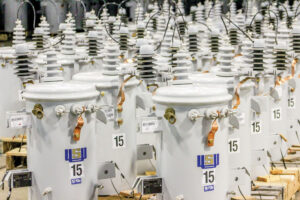Unprecedented electricity demand and lagging infrastructure development could place many regions of the U.S. at risk of power supply shortages over the next decade, particularly during periods of extreme weather, the North American Electric Reliability Corp. (NERC) said in a new report.
Over the next five years, NERC forecasts that all or parts of 19 states from Montana to Louisiana are at high risk of rolling blackouts during normal peak conditions. And most of the rest of the country is at similar risk when demand for electricity spikes during exceedingly hot or cold temperatures.
In its 2023 Long-Term Reliability Assessment, released Dec. 13, NERC warned that planned retirements of baseload power plants, transmission congestion, fuel supply issues and inadequate maintenance increase the risks of prolonged service disruptions during major winter cold snaps or summer heatwaves.
“NERC’s latest assessment paints a grim picture of our nation’s energy future as demand for electricity soars and the supply of always-available generation declines,” National Rural Electric Cooperative Association CEO Jim Matheson said.
Matheson is among the energy industry leaders urging government agencies and policymakers to reconsider regulations that threaten to exacerbate regional shortfalls and support initiatives that could help meet energy demand at costs consumers are able to bear.
“Nine states saw rolling blackouts in December 2022 as the demand for electricity exceeded available supply. And proposals like the Environmental Protection Agency’s power plant rule will greatly compound the problem,” said Matheson. “Absent a major shift in state and federal energy policy, this is the reality we will face for years to come.”
NERC’s report noted that some areas have improved generation and transmission, which could help ensure adequate reserves through 2028. However, resource shortfalls could become more common, based upon demand growth, anticipated retirements of older power plants, and slow or stalled development of new generation.
“Demand is rising, and the resource generation mix is declining,” said Mark Olson, NERC’s manager of reliability assessments.
The report warns that the nation’s bulk power system must be maintained to respond to demand during extreme weather events. “Generator performance and fuel issues are more likely to occur when generators are called upon with short notice,” analysts said.
Portions of the Midwest from the western Great Lakes to the Gulf of Mexico, which includes Illinois, are categorized as “high risk,” due in part to what analysts describe as “overly rigid” environmental regulations and energy policies threatening grid reliability.
These policies have the “potential to influence generators to seek deactivation despite a projected resource adequacy or operating reliability risk,” analysts wrote. “Regulators and policymakers need to consider effects on the electric grid in their rules and policies and design provisions that safeguard grid reliability.”









